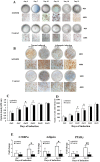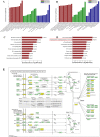LncRNA expression profiling of BMSCs in osteonecrosis of the femoral head associated with increased adipogenic and decreased osteogenic differentiation
- PMID: 29904151
- PMCID: PMC6002551
- DOI: 10.1038/s41598-018-27501-2
LncRNA expression profiling of BMSCs in osteonecrosis of the femoral head associated with increased adipogenic and decreased osteogenic differentiation
Abstract
Long noncoding RNAs (lncRNAs) are critical gene expression regulators and are involved in several bone diseases. To explore the potential roles of lncRNAs in osteonecrosis of the femoral head (ONFH), we investigated for the first time the lncRNA expression profile of bone marrow mesenchymal stem cells (BMSCs) from patients with steroid-induced ONFH (SONFH) with microarray and bioinformatics analysis. A total of 1878 lncRNAs and 838 mRNAs were significantly up-regulated while 1842 lncRNAs and 1937 mRNAs were statistically down-regulated in the SONFH group compared with control group. The results validated by qRT-PCR were consistent with the microarray profiling data, especially involved in upregulation and downregulation of critical lncRNAs as well as mRNAs expression related to adipogenic and osteogenic differentiation. Pathway analyses revealed 40 signaling pathways with significant differences, especially the signaling pathways to regulate stem cell pluripotency. The CNC and ceRNA network indicated that lncRNA RP1-193H18.2, MALAT1 and HOTAIR were associated with abnormal osteogenic and adipogenic differentiation of BMSCs in the patients with SONFH. Our results suggest the lncRNA expression profiles were closely associated with the abnormal adipogenic and osteogenic transdifferentiation of BMSCs during the development of SONFH and explore a new insight into the molecular mechanisms of SONFH.
Conflict of interest statement
The authors declare no competing interests.
Figures






Similar articles
-
MiR-15b ameliorates SONFH by targeting Smad7 and inhibiting osteogenic differentiation of BMSCs.Eur Rev Med Pharmacol Sci. 2019 Nov;23(22):9761-9771. doi: 10.26355/eurrev_201911_19539. Eur Rev Med Pharmacol Sci. 2019. PMID: 31799643
-
Circular RNA CDR1as promotes adipogenic and suppresses osteogenic differentiation of BMSCs in steroid-induced osteonecrosis of the femoral head.Bone. 2020 Apr;133:115258. doi: 10.1016/j.bone.2020.115258. Epub 2020 Feb 1. Bone. 2020. PMID: 32018039
-
Identification of long non‑coding RNAs expressed during the osteogenic differentiation of human bone marrow‑derived mesenchymal stem cells obtained from patients with ONFH.Int J Mol Med. 2020 Nov;46(5):1721-1732. doi: 10.3892/ijmm.2020.4717. Epub 2020 Aug 31. Int J Mol Med. 2020. PMID: 32901839 Free PMC article.
-
Recent advances in osteonecrosis of the femoral head: a focus on mesenchymal stem cells and adipocytes.J Transl Med. 2025 May 27;23(1):592. doi: 10.1186/s12967-025-06564-6. J Transl Med. 2025. PMID: 40426076 Free PMC article. Review.
-
Research progress on the role of lncRNA-miRNA networks in regulating adipogenic and osteogenic differentiation of bone marrow mesenchymal stem cells in osteoporosis.Front Endocrinol (Lausanne). 2023 Aug 14;14:1210627. doi: 10.3389/fendo.2023.1210627. eCollection 2023. Front Endocrinol (Lausanne). 2023. PMID: 37645421 Free PMC article. Review.
Cited by
-
The regulatory activities of MALAT1 in the development of bone and cartilage diseases.Front Endocrinol (Lausanne). 2022 Nov 14;13:1054827. doi: 10.3389/fendo.2022.1054827. eCollection 2022. Front Endocrinol (Lausanne). 2022. PMID: 36452326 Free PMC article. Review.
-
C/EBPα regulates the fate of bone marrow mesenchymal stem cells and steroid-induced avascular necrosis of the femoral head by targeting the PPARγ signalling pathway.Stem Cell Res Ther. 2022 Jul 26;13(1):342. doi: 10.1186/s13287-022-03027-3. Stem Cell Res Ther. 2022. PMID: 35883192 Free PMC article.
-
PiRNA-63049 inhibits bone formation through Wnt/β-catenin signaling pathway.Int J Biol Sci. 2021 Oct 25;17(15):4409-4425. doi: 10.7150/ijbs.64533. eCollection 2021. Int J Biol Sci. 2021. PMID: 34803507 Free PMC article.
-
The role of biomechanical forces and MALAT1/miR-329-5p/PRIP signalling on glucocorticoid-induced osteonecrosis of the femoral head.J Cell Mol Med. 2021 Jun;25(11):5164-5176. doi: 10.1111/jcmm.16510. Epub 2021 May 3. J Cell Mol Med. 2021. PMID: 33939272 Free PMC article.
-
17 variants interaction of Wnt/β-catenin pathway associated with development of osteonecrosis of femoral head in Chinese Han population.Sci Rep. 2024 Mar 27;14(1):7301. doi: 10.1038/s41598-024-57929-8. Sci Rep. 2024. PMID: 38538713 Free PMC article.
References
Publication types
MeSH terms
Substances
LinkOut - more resources
Full Text Sources
Other Literature Sources

